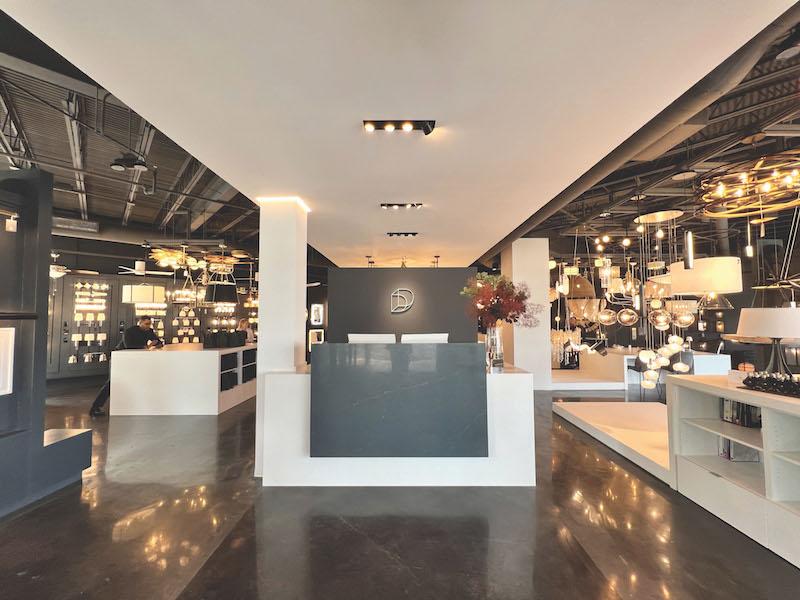In the interior design and retail world, everyone’s on Instagram, Facebook and other social channels. We all seem to be competing for the same airspace with many other brands.
In today’s marketing environment, consumers are overloaded with information, some they need, some they don’t. As an independent retailer or designer, how do you get your voice heard above the noise?
You find the white spaces, Robin Baron, Interior and Product Designer for Robin Baron Design, says. In a recent panel on how to face economic issues, held in the Minka Group showroom at Lightovation, Baron talked about finding the marketing niches that are likely not as crowded. That could mean going back to physical mailings or finding the newest digital spaces to engage with customers. You can read more about Baron’s and our other panelists’ thoughts on thriving in challenging times on
page 33.
From in-person events to activations in the Metaverse, designers and retailers are finding new ways to get customers and clients engaged.
Creative Connections
For Cheryl Kees Clendenon, Interior Designer, Home Furnishings Retailer and Design Coach for In Detail Interiors, in Pensacola, FL, her marketing approach starts with what’s in it for her customers and clients. “You have to be focusing on the individual experience,” she says. “If you’re a high-end boutique retailer, what will make you stand out in the relationships you build?” Today’s consumer can get anything from anywhere, and their attention can be scattered. To capture the consumer’s attention today, your marketing focus needs to target just that one person, in a sense, she notes.
That individualized approach starts with social media and your website. So often, Clendenon sees designers focusing on themselves in their marketing efforts — their style, their personality, etc. While it’s important to put yourself out there so your potential customers can get to know you, it’s equally as important to ensure your marketing message is framed in a way that it’s about what you can do for your clients and customers. “You have to help your potential clients see themselves in your words,” she says.
You also need to be authentic, a word that can be overused today, but it’s still important, Clendenon says. “For example, humor is a big deal to me. I don’t bill myself as a high-end luxury designer; it’s not what I aspire to. I use humor to grab people,” she says.
Your personality and vibe is what is going to attract your ideal customers, so being yourself is important in all of your marketing. “We had one client come to the shop to meet us, and we realized he was looking for a more sophisticated, ‘stuffy’ approach. That wouldn’t have been a good fit for us,” Clendenon adds.
To ensure you are marketing to the right people for you, it’s important to have a distinctive point of view, starting with your website. “You want all of your marketing to replicate what it would be like to work with you.”
Even after you’ve connected with and signed a client, you will still be marketing. For Clendenon, part of that involves getting the money conversation out of the way immediately. Clendenon has a flat-fee approach to payment, and by addressing that first, clients can relax and the rest of the process can be about design. “I want to be a partner in this process. I’m helping to create the experience that I want,” she says. “It’s important to note that this is a marketing decision as well as anything else.”
When someone books a paid appointment with her, she’ll send a gift immediately. “We’ll send a gift card, say something clever, and everything is branded. Now they’ve received a present before they’ve even met us. And it comes in the mail,” she says. This is all part of the experience of working with In Detail Interiors. It’s about making the client feel seen, heard and special.
At retail, Clendenon also engages with her customers in ways that help them experience her store rather than just shop it. “With our retail customers, we are looking to develop brand advocates, individuals who will multiply the word about us and influence others,” she says.
To that end, Clendenon and her staff create experiences for customers and non-customers alike. In the last year, she began offering candle parties, and those events have created an amazing opportunity. In addition to providing a fun activity for customers where they can relax, make something and enjoy themselves for a while, she’s also creating a marketing opportunity because these customers review the store positively and often return as loyal customers. “When we upped our game with this, we found an amazing opportunity,” she says. “If you have a store, you can do this. If you want to be successful in marketing you need to be really creative.”
Clendenon also recommends connecting with other retailers or events in your community and working together to get exposure to new potential customers, or if you are a designer, find new clients.
“It’s not about how much money these things will bring in. That’s not the point,” she notes. “There are different types of currency. The dollar bill is not as direct anymore. It’s about getting this residual marketing. This mindset has been the biggest shift to my personal income.”
Clendenon also recommends really paying attention to the customers who are in your store. “If you’re a retailer, get down there and talk to people. That’s when I get my best intel,” she says. “I like to measure everything. We’re a smaller retail business so we can track people who come through the store as well.” From that tracking Clendenon gets a good idea of who her customers are, how they fit into specific demographics — which are not the same as they used to be — and learns what resonates and what doesn’t. To get more information on her customers, she’ll create brand pop-ups and ask customers to vote on the ones they like and why. That approach gives Clendenon the information she needs, and creates an interactive environment for customers, who now have a sense of ownership as they browse her showroom. Those cards can also enter to win something. “It gets results,” she notes.
While some of Clendenon’s approach feels like a throwback to less digital times, for younger consumers, particularly, these are new experiences sans screens
and it resonates.
Defining a Brand
For Matthew Rowan, Vice President of Residential Lighting and Marketing for Dominion Lighting, his focus has been reimagining the lighting retail experience and delivering something unique for the retailer’s customers. To date, Rowan has headed up extensive showroom resets in two of Dominion’s three Virginia locations — Arlington and Chantilly.
The first renovation in Arlington happened about two years ago, and Dominion has received awards for its efforts and has seen increased revenue as a result. More importantly, the updated venue has become an experience for customers who visit, whether to just purchase lighting, attend an art gala or even take wedding photos. Complete with local art and a signature scent and playlist, Rowan and his team haven’t ignored any detail that creates an experience for Dominion’s customers.
Several months ago, similar renovations were completed on Dominion’s Chantilly location, and Rowan took lessons learned from Arlington to make Chantilly even more consumer-centric.
“We can’t forget what we do in home retail and design. The result is always an in-person result,” he says. “People don’t experience their homes virtually. There will be that hunger for a personal experience at the beginning of the process.”
Taking what the team learned from the Arlington lighting showroom, Rowan says, he knew that the Chantilly space needed to be an experience as well, and currently is hosting an art show featured around local artists. “We know better now how to meld the lighting with the art as a demonstration. It’s more dramatic as we’re using the light now to create shadows,” he says, which creates a specific mood around the artwork.
He also learned that the VIP experience for customers needed to be ramped up. While both stores have a private light lab for customers to learn about different lighting options and how they will look at home, the Chantilly lighting lab has a separate entrance so customers don’t even have to walk through the store. The new light lab is always filled with fancier snacks and beverages as well as an espresso machine. Perrier water, for example, provides a much higher-end feel than a local filtered water. “We doubled the amount of fancy snacks and beverages. These things we do as giveaways create a heightened experience,” he says. “We made the space somewhere you want to go, an experience and a destination. The showroom also feels like a space where you can explore and discover things.”
Like Clendenon, Rowan pays close attention to how customers interact with the space. “It’s not done when you have your grand opening,” he says. “You have to keep watching and changing the space accordingly. The experience has to evolve through the seasons so people want to come back.” Understanding your customer and how and what they shop for is critical to effective marketing. For example, while incomes and renovation spends are similar in the two areas surrounding these Dominion locations, Chantilly is a more suburban/rural environment and the scale of light fixtures tends to be larger than the more urban Arlington environment. “A lot of people think they have a concept for a store and it’s just a matter of finding a venue. It has to be the other way around. The venue has to inform what you are going to sell there,” he says.
As lighting showrooms, too, creating an atmosphere with light, even at night, entices consumers to visit the stores. Rowan also advertises both Dominion locations in local print publications, opting out of direct mail campaigns. “It’s a good place for us to advertise,” he says.
While physical marketing — events, ads and more — are still important, Rowan also understands the power of the Internet, and how important it is to connect with customers and deliver an experience there as well. To that end, Rowan optimizes Google ads, has rebranded the website to mirror the physical store locations, and while the goal is to get customers to make appointments with a Dominion designer who can assure they get the proper lighting, it allows customers to create wishlists online and explore a bit on their own.
When the Chantilly grand opening was moved up, Rowan had to pivot from the anticipated physically mailed invitations to sending them digitally. It didn’t hurt the grand-opening turnout and saved a significant cost had those invitations gone out.
Paying attention to the customers provides the data that lets you know how successful your efforts are. You just need to know where to look. How many people came in from an ad in a magazine? How many have gone directly to the website? That’s a measure. Pay attention to website analytics and see where the spikes occur. Those could be the result of an event. “The data is out there,” Rowan says. “You just need to know where to look and be vigilant about it.”
Being Ahead of the Crowd
Leslie Carothers, Principal of Savour Partnership, has a more digital approach to marketing that she teaches designers and retailers how to leverage. And while her focus is primarily via a screen, it still requires connecting with potential clients in a big way.
One of the first strategies she suggests is creating a Facebook group or community that can connect you with potential clients/customers in your region.
You can use your Facebook page to advertise into your local zip codes, where you can share what you do and the focus of your group. Let them know what they can expect to get from a content standpoint from your group — maybe design tips, organization or some of the latest home furnishings trends. Put money into ads and people will start joining your community. “Those people are choosing to be connected with you,” Carothers says. “They essentially become your brand ambassadors in your community because they end up liking you if you treat them well. In the group I’ve had for seven years, people know me now. They value the free content that I give them, and they understand they are getting good information.”
She cautions that content can’t be about your latest sale. “Your job as a community manager is adding value to your audience,” she continues. It’s also important to engage with your audience, so they know they’re being heard. Adding that value takes time and effort but the payoff is an engaged community that will use your services, visit your store or talk about you in a positive way, bringing you other potential customers and clients.
As Baron mentioned, it also pays to play in the white spaces, where not everyone is just yet. Carothers recommends testing out the new social app, Threads, for example. “You might not pick up new clients here but it’s a good place to showcase your brand and ask questions of the audience,” she says. Again, it’s more about sharing information than making a sale, but building that trust and letting people get to know you can really help boost your design or retail business.
To go really cutting-edge, Carothers has been sharing a great deal of information about the Metaverse. The bigger fashion brands are already creating events and selling in the metaverse, and even fashion weeks have been conducted in Metaverse activations.
Today, you can create a white label Metaverse activation right on your website, host a party or event, and sell directly if you have an ecommerce site. As with gaming, people can control their Avatars in your activation, creating an interactive, almost in-person experience depending on the technology. 3D glasses for example can move an activation from a 2D to 3D experience. Carothers hosts classes on using the Metaverse.
“It provides a fun way to experience your store or something you’ve designed, and it can attract a lot of attention,” she says. “Younger fashion-forward consumers who have a lot of money are getting used to buying this way.”
Putting all of these things together — social media platforms, groups, the Metaverse — is an ecosystem that all works together. With a little money and training, it’s possible to create an environment that can deliver brand awareness, customers and more. “It establishes credibility and thought leadership with your potential customers,” she says.
Whatever your preference for effective marketing to your customers, the bottom line is creative connection, and finding the efforts and tools that will intrigue and then resonate with them.







